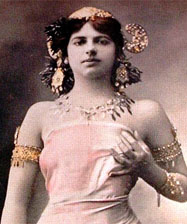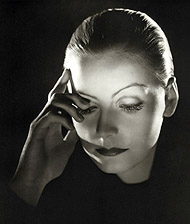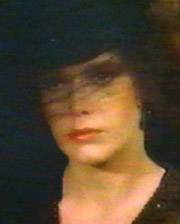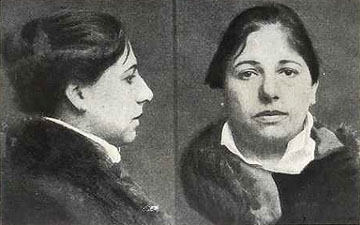|
Mata Hari[ This text is also available in Swedish ] Incredibly beautiful belly dancer and master spy
Of the many, many myths that surround Mata Hari, only a fraction will be examined here. She would definitely have been all but forgotten today, had she not been shot for espionage. If she was indeed guilty, and in that case for what, is a complex issue, considerably more so than the factoids above. Margaretha Geertruida Zelle was born in 1876 in Leeuwarden, the Netherlands. Under the artist name of Mata Hari she made a comet career as an "exotic dancer" in lavish settings with a less than genuine indian/oriental touch. She was said to be a javanese princess; the daughter of a Brahman priest; or something similar -- all make-believe promotional bullshit, made possible by her dark eyes, hair and complexion (though she wouldn't have fooled nearly as many in Jakarta or Bombay as in Paris, of course). She did, however, have a connection to Java (then part of the Dutch empire), having lived there 1897-1902. To spice up one's background in this manner was quite common for artists at the time. Despite this, a surprising number of newspapers of surprisingly high standards passed on these rumours, and more, as facts - sloppy journalism, too, was quite common at the time.
What about the great looks and the dancing? First, let's do a numerical analysis: When Greta Garbo did her part (in the all but fictionary movie which probably have contributed more than anything else to the general image of Mata Hari) she was 26 years old and looked like - well - like Greta Garbo. Sylvia Kristel, of Emmanuelle fame, was 33 in 1985. The gift of Margaretha Zelle never was great looks as much as charisma and sex appeal. At her execution in 1917 she was 41, and had her dancing well behind.
Most of the dancing took place in 1905-06, then the assignments gradually became fewer and worse paid, until 1915. She now lived on her lovers; "Although well past her prime, she remained a name" (Howe). Her living standards varied considerably despite her international fame; sometimes she spent months at the best hôtels of Paris, sometimes she survived on quite limited means - sometimes simultaneously. Downright prostitution did occur, though she never accepted any customers whatsoever. (Her preference of men in uniform - rather a poor officer than a rich banker, as she put it (Keay, page 124) - would contribute to her end.) In the genuine jet set, she was a temporary visitor. As far as her dancing is concerned she was an autodidact, and her shows had really nothing to do with anything one can find in the Middle East, India or Southeast Asia. The point of marketing herself as a native woman of class who shared the ancient culture of the Orient etc. was that the nobility (men and women alike) for the first time ever could sit and watch someone undress. That would also be her lasting (?) contribution; to make strip tease acceptable. The words mata hari literally means "the eye of the day", compounded to matahari (she also spelt it "Mata-Hari") it means, literally, "sun" in Indonesian (similar meanings in related languages like Malayan); today it's also the name an Indonesian supermarket chain. Her first artist name was "Lady MacLeod" after a supposed lord father, and it didn't disappear from the posters until 1912, when the real MacLeod (her former husband) sued her. Mata Hari as a spyWhat follows is, with necessity, a simplification. In August 1916, Captain Ladoux, head of the French counterespionage, told her that the British considered her a German spy. He didn't believe them, he said, but wondered if she would like to work for the Republic? She eventually accepted; a single mission on the highest level, for the mind-boggling price of one million franc. On her way to Belgium and her supposed mission, she was arrested by the British who took her for another spy. After her release, she had to go to Madrid, and that's essentially where her entire career as a spy took place, during two weeks in December 1916. For a start, she contacted the German embassy to gain their trust - she was to turn into a double agent. That the name of Mata Hari has become synonymous with a master spy is definitely a factoid, considering her very short career as well as her very limited skills in the craft (even when compared to her colleagues), not to say naïvety. (Like when she attempted to dicuss her mission in clear in ordinary mail or over a plain telephone, or when she refused to use invisible ink.) The German military attaché obviously found this out within minutes. Mata Hari apparently didn't understand she had been revealed, but returned to Paris, happy with the (worthless) intelligence she thought she had fooled out of the attaché. During her stay in Madrid, the counterespionage in Paris intercepted German messages which contained enough information to identify their agent H 21 as Mata Hari. But this code showed that she had been a German agent well before arriving in Madrid! The British had apparently been right all the time. But the H 21-messages were supposed to be read by the enemy - they were encrypted with a code the Germans knew had been broken. Since the French counterespionage initially failed to realize this, Mata Hari was arrested in February 1917. It was never revealed during the trial. The problem was that Mata Hari had indeed accepted to work for the Germans. In May 1916 she accepted the payment of twenty thousand francs (for services delivered, as the prosecution would later claim) which at the time was a small fortune. She insisted that she wanted to fool Germany of the money as payment for some furs she earlier had lost due to the involvement of that nation, and that she never gathered any intelligence for them. If she actually got the money for nothing, it would explain why the Germans had aggressions toward a useless agent, instead of feeding her with desinformation. But was it true? In that case she must have realized the risk she took when she made contact with the Germans in Madrid - on the other hand, she couldn't possibly have told Ladoux why she didn't really qualify as a German double agent, and then there was this dream of a million franc... This is at least what Howe thinks, heavily condensed, and since his investigation is the most careful by far I've read it's hard to disagree. Whether Ladoux knew she was innocent or not is another question. The court didn't believe her, in particular since they never got to see all the evidence, nor did they hear some key witnesses who could have defended Mata Hari. She was executed at October 15, 1917. M. was a mythomaniac; if or in what degree she was a secret agent remains in doubt. Nationalencyklopedin, the National Encyclopaedia of Sweden It's worth noting that no German spies have claimed that Mata Hari was part of their organization (Howe, page 260) but actually denied it (Howe, page 284). Whether she was a mythomaniac, PR-minded, naïve or simply had bad memory - or all of it - it's a fact that many of the myths that surround her were of her own fabrication. Other contributors include the investigation and the trial (Howe lists a myriad errors, from spelling to obviously faked H 21-messages), other biographers (even including her own father, who in 1906 wrote a completely unreliable biography), contributors of popular culture, and so on. It is hard to conceive of a subject that has been so badly reported, despite the lady's enormous fame. R. W. Howe, from the Author's Note Sources:
Keay's book is slightly easier to read, but then again she's somewhat more sloppy than the utterly careful Howe. He often notes how hard even the officials had with some names, like Kroemer (who paid the twenty thousand francs) who is named Krämer and Krömer, just to name but a few variants. Keay calls him Kramer (possibly an anglified "Krämer"), the Madrid attaché Arnold Kalle is called von Kalle, Georges Ladoux is called Pierre in one illustration text, and so on. She's also fond of telling us exactly what the people involved thought, even when the available evidence would make a more careful observer avoid this risky business. Even more serious is her accepting the faked (by Ladoux?) H 21-messages as the real ones. And so on. Despite those errors, she does arrive at the same conclusion as Howe, that Mata Hari was no spy, but naïve beyond excuse. |






